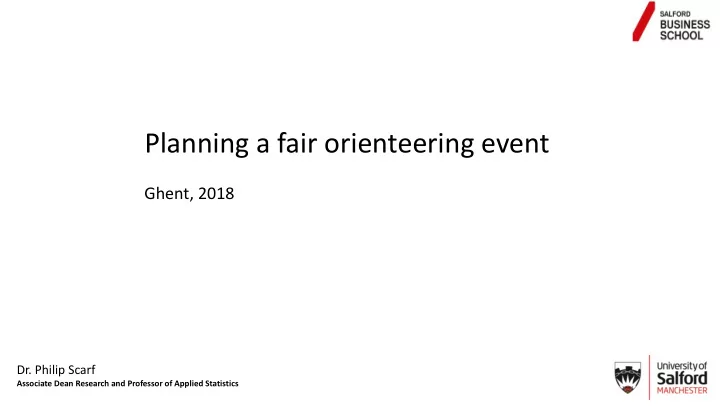

Planning a fair orienteering event Ghent, 2018 Dr. Philip Scarf Associate Dean Research and Professor of Applied Statistics
Sports with issues of fairness: • Score orienteering • Basketball? • Seeding in KO tournaments in general? Dr. Philip Scarf Associate Dean Research and Professor of Applied Statistics
Dr. Philip Scarf Associate Dean Research and Professor of Applied Statistics
Dr. Philip Scarf Associate Dean Research and Professor of Applied Statistics
Dr. Philip Scarf Associate Dean Research and Professor of Applied Statistics
Dr. Philip Scarf Associate Dean Research and Professor of Applied Statistics
Dr. Philip Scarf Associate Dean Research and Professor of Applied Statistics
Dr. Philip Scarf Associate Dean Research and Professor of Applied Statistics
Dr. Philip Scarf Associate Dean Research and Professor of Applied Statistics
Dr. Philip Scarf Associate Dean Research and Professor of Applied Statistics
Dr. Philip Scarf Associate Dean Research and Professor of Applied Statistics
Some observations and questions • The planner assigns scores to nodes (controls) • Setting a course S in which n i of the nodes have score s i for i =1,…, k (subject to some loose constraints on the n i ) • Suppose competitor j has a path-length limited to L j • We shall call the orienteering problem “fair” if the maximum score possible for competitor j is proportional to L j for all j in C • “ All else equal, equal points for equal running” • Is this a good definition of “fair”? • A clearable course benefits the faster runners • How does one plan a fair course? • What is a fair assignment of scores to nodes? Dr. Philip Scarf Associate Dean Research and Professor of Applied Statistics
Some further issues • In real orienteering problems, “edge lengths” are stochastic: what is the effect of this upon the effectiveness of solution algorithms? • What are some good solution heuristics for a human competitor? • Is the human brain a good orienteering problem solver? • Overtime penalties Dr. Philip Scarf Associate Dean Research and Professor of Applied Statistics
No solutions, only questions… Dr. Philip Scarf Associate Dean Research and Professor of Applied Statistics
Recommend
More recommend